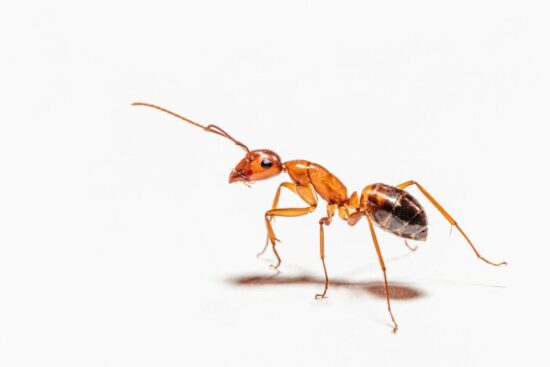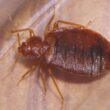Understanding how long ants live is super important when dealing with an ant problem in your home. Different types of ants have wildly different lifespans, and this directly affects how you should treat them and how long it takes to get rid of them completely. Some ants live just a few weeks, while others can stick around for decades.
Knowing these differences helps you pick the right treatment and set realistic expectations for when the ants will be gone for good.
1. Queen Ants Live the Longest (15 to 30 Years)
Queens are the marathon runners of the ant world. These egg-laying superstars can live anywhere from 15 to 30 years, depending on the species. Black garden ant queens have been known to live nearly 30 years, while carpenter ant queens typically survive 10 to 25 years. Fire ant queens usually make it to about 7 years, which is still pretty impressive for such a tiny creature.
This long ant lifespan for queens is exactly why surface sprays that only kill the worker ants you see are basically useless. The queen stays hidden deep in the nest, pumping out thousands of new eggs. If your treatment doesn’t reach and eliminate the queen, you’ll be dealing with the same ant problem over and over again.
- Attracts and kills ants you see and the colony you don’t
- Fast results—see fewer ants in just days
- Ready-to-use stations, no mess or setup needed
- Perfect for kitchens, bathrooms, and any ant hotspots
Queens are much larger than regular worker ants. Carpenter ant queens can grow up to an inch long, making them pretty easy to spot if you do see one. During certain times of the year, they might have wings when they’re ready to start new colonies. But most of the time, queens stay hidden in their nests where they’re safe and can focus on laying eggs.
2. Worker Ants Are What Most People See (Weeks to Years)
Worker ants are the ones marching across your kitchen counter and getting into your food. These are all female ants, but unlike queens, they can’t reproduce. How long ants live as workers varies a lot by species, and this affects how quickly treatments work.
Fire ant workers have some of the shortest lifespans at just 5 weeks on average, though they can live anywhere from 30 to 180 days depending on conditions. Pharaoh ants, those tiny yellow pests, typically live about 70 days as workers. On the other end of the spectrum, odorous house ant workers can live 2 to 3 years, and carpenter ant workers can survive anywhere from 1 to 7 years. Pavement ants usually live 1 to 3 years as workers.
These different lifespans matter a lot for pest control. If you’re dealing with fire ants that only live 5 weeks, you might see results from treatment pretty quickly. But if you have carpenter ants with workers that can live for years, it might take much longer to see the full effects of your treatment.
3. Carpenter Ants Can Destroy Your Home for Decades
Carpenter ants are particularly scary for homeowners because they can damage the structure of your house. Worker carpenter ants live 1 to 7 years depending on conditions, while their queens can survive 10 to 25 years or more. This means carpenter ant colonies can keep going for decades if left untreated, slowly eating away at your home’s wooden structure.
These large black ants are pretty easy to identify. Workers are typically 3/8 to 1/2 inch long, making them some of the biggest ants you’ll see in your house. They love areas with moisture-damaged wood and often leave behind sawdust-like material called frass near their nesting spots. You might even hear rustling sounds coming from inside your walls where they’re working.
Because carpenter ants have such long lifespans, expect treatment to take at least 2 to 3 weeks before you see major results. The good news is that once you eliminate the colony, including the long-lived queen, they won’t be coming back to that same spot.
4. Fire Ants Multiply Fast Despite Short Lives
Fire ants are interesting because individual workers don’t live very long, but their colonies can explode in size incredibly quickly. Worker fire ants typically live just 35 days in warm weather, though they can survive several months during cooler winter periods. However, fire ant queens live up to 7 years and can lay up to 1,500 eggs every single day.
This combination of short worker lives but crazy-fast reproduction means fire ant problems can get out of control really quickly. Even though individual ants don’t live long, there are always new ones being born to replace them. Some fire ant colonies can contain over 250,000 individuals.
Fire ants are reddish-brown and measure about 1/8 to 1/4 inch long. They’re known for their aggressive behavior and painful stings. You’ll typically see them building distinctive dome-shaped mounds in your yard. Because of their short ant lifespan for workers but high reproduction rate, fire ant treatments often show results within 1 to 2 weeks.
5. Pharaoh Ants Are Tricky Indoor Pests
Pharaoh ants are some of the most frustrating ants to deal with, even though worker ants only live about 70 days on average. The problem is their behavior. When Pharaoh ant colonies get disturbed or feel threatened, they split apart and create new colonies in a process called “budding.” This means using the wrong treatment can actually make your ant problem worse.
These tiny ants are only about 1/16 inch long and range from yellow to light brown in color. They have a two-segmented club at the end of their antennae, which helps tell them apart from other small ants. Pharaoh ants love warm, humid areas and are often found near heat sources like water heaters or heating vents.
The relatively short lifespan of Pharaoh ant workers means treatments can work fairly quickly once you use the right approach. However, because these colonies can have multiple queens and the budding behavior, you need to use special baiting strategies rather than sprays or other treatments that might scatter the colony.
6. Odorous House Ants Stick Around for Years
- Attracts and kills ants you see and the colony you don’t
- Fast results—see fewer ants in just days
- Ready-to-use stations, no mess or setup needed
- Perfect for kitchens, bathrooms, and any ant hotspots
Odorous house ants are named for the rotten coconut smell they give off when crushed. These ants are particularly stubborn because their workers have one of the longest lifespans among common household ants, living 2 to 3 years on average. This means treatments often take several weeks to months to show full effectiveness.
These small ants are about 1/8 inch long and dark brown to black in color. They’re highly adaptable to indoor environments and seem to love getting into kitchens where they can find sweet foods. How long ants live matters a lot with this species because their extended lifespan means the colony can keep going even if food sources become scarce for a while.
Because odorous house ant workers live so long, patience is key when treating them. The ants carrying bait back to the colony need time to share it with all the other long-lived workers and eventually reach the queen.
7. Pavement Ants Live Under Your Foundation
Pavement ants are probably the most common ants in many parts of the United States. Worker pavement ants typically live 1 to 3 years, which puts them in the middle range for ant lifespans among household species. They get their name because they love to nest underneath sidewalks, driveways, and house foundations.
These medium-sized ants are about 1/8 inch long and range from light brown to black. You can identify them by the parallel grooves on their head and thorax that look like tiny lines. You’ll often see small piles of soil near cracks in pavement where they’ve been excavating their nests.
With their moderate lifespans, pavement ant treatments usually require consistent baiting over 2 to 4 weeks for complete colony elimination. The key is being patient and keeping bait stations fresh until all the long-lived workers have had a chance to consume the poison and share it throughout the colony.
8. Male Ants Have the Shortest Lives
Male ants, also called drones, have the shortest ant lifespan of all. These guys live only 1 to 2 weeks and have just one job: mating with queens. Once they’ve done their duty, they die within days. Male ants are only around during certain times of the year when colonies are ready to reproduce.
If you see winged ants flying around your house, especially during spring or summer, these are likely male ants (and female future queens) on their mating flights. This is actually bad news for homeowners because it means there’s a mature, well-established colony somewhere nearby that’s healthy enough to produce reproductive ants.
While male ants themselves aren’t a direct pest problem because they die so quickly, seeing them is a warning sign that you need to take action against the main colony soon.
9. Weather and Food Affect How Long Ants Live
Several factors can make ants live longer or shorter than usual, and understanding these helps with pest control timing. Temperature plays a big role. Cold weather actually extends ant lifespans because their metabolism slows down, while hot weather shortens their lives. This is why you might see more ant activity during certain seasons.
Food availability also matters a lot. Well-fed ants live much longer than hungry ones. Ants can actually survive 1 to 2 weeks without food, but only about 5 days without water. This means cutting off their food and water sources can be an effective part of your control strategy.
In natural outdoor settings, predators and competition with other insects can shorten how long ants live. But inside your house, where it’s safe and food is plentiful, ants often live longer than they would in the wild.
10. Ant Lifespans Determine How Fast Treatments Work
- Attracts and kills ants you see and the colony you don’t
- Fast results—see fewer ants in just days
- Ready-to-use stations, no mess or setup needed
- Perfect for kitchens, bathrooms, and any ant hotspots
Understanding how long ants live helps set realistic expectations for pest control treatments. Most bait treatments take 2 to 3 weeks on average to eliminate ant colonies completely, but this varies a lot based on the species and their lifespans.
For species with shorter-lived workers like fire ants and pharaoh ants, you might see results in just 1 to 2 weeks. The ants don’t live long enough to keep the colony going once the bait starts working. For species with moderate lifespans like pavement ants, expect 2 to 4 weeks for complete elimination.
The longest waits are for species like carpenter ants and odorous house ants, where workers can live for years. These treatments might take 4 to 8 weeks to completely eliminate established colonies because it takes time for the bait to reach all the long-lived workers.
Remember, eliminating the queen is essential regardless of how long the workers live. Without the queen, no new ants are being born, and eventually the colony dies out.
11. How to Tell if Treatment Is Working
It’s totally normal to see more ants initially after starting treatment. This happens because the ants are actively carrying poisoned bait back to their nests and sharing it with other colony members. Don’t panic and spray them, this is actually a good sign that the treatment is working.
For most species, expect to see a significant reduction in ant activity after 2 to 3 weeks. Complete elimination might take 1 to 2 months for well-established colonies, especially those with long-lived workers. If you’re still seeing new workers appearing after 6 to 8 weeks, it’s probably time to re-treat or try a different approach.
Species with shorter lifespans like fire ants usually show results within 1 to 2 weeks. Longer-lived species like carpenter ants and odorous house ants may require 4 to 8 weeks for complete elimination. The key is being patient and not switching treatments too quickly.
12. Prevent Future Problems Based on Ant Biology
Knowing how long different ants live helps you plan prevention strategies. For species with multi-year lifespans like carpenter ants, you need long-term monitoring even after successful treatment. These colonies can take a long time to fully die out, and stragglers might try to restart the colony.
Seasonal treatment timing works well for most species. Quarterly treatments around your home’s perimeter can prevent new colonies from getting established. For shorter-lived species in ideal climates, bi-annual treatments might be enough.
Moisture control is super important for long-lived species like carpenter ants that can keep colonies going for decades. Fix any leaks, improve ventilation, and replace water-damaged wood to make your home less attractive to these persistent pests.
For really persistent species or structural pests like carpenter ants, monthly monitoring helps catch problems early before they become major infestations.
Understanding ant lifespans is the key to successful pest control. Different species require different approaches based on their biology, and patience is essential since even fast-acting treatments must work through entire colony lifecycles. When dealing with long-lived species like carpenter ants or facing repeated infestations, it’s often worth calling in professional pest control experts who understand these biological differences and can create targeted treatment plans.



